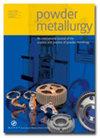激光粉末床熔合制备Fe-16Mn-10Al-5Ni-0.86C轻钢的磨损性能
IF 1.8
4区 材料科学
Q2 METALLURGY & METALLURGICAL ENGINEERING
引用次数: 0
摘要
本文章由计算机程序翻译,如有差异,请以英文原文为准。
Wear properties of Fe-16Mn-10Al-5Ni-0.86C lightweight steel manufactured by laser powder bed fusion
ABSTRACT Microstructural characteristics and wear properties of Fe-16Mn-10Al-5Ni-0.86C lightweight steel (LWS) manufactured by laser powder bed fusion (LPBF) process were investigated and compared with conventional LWS. Both LWS alloys constituted an austenite matrix and B2-IMC. The LPBF LWS sample showed polygonal-typed B2-IMC, whereas conventional LWS had rod-typed B2-IMC. The ball-on-disk method was used to perform a wear test at 25°C under three different load conditions of 20N, 3N and 40N. The wear results indicated that the LPBF LWS sample exhibited a similar amount of wear loss under the 20N and 30N load conditions, but it showed better wear resistance under the 40N compared to conventional LWS. After the wear test, the abrasive wear behaviour was confirmed as the main wear mechanism in both LWSs. The formation of oxide layers and debris was analysed through observation of the cross-sectional area of the worn surface.
求助全文
通过发布文献求助,成功后即可免费获取论文全文。
去求助
来源期刊

Powder Metallurgy
工程技术-冶金工程
CiteScore
2.90
自引率
7.10%
发文量
30
审稿时长
3 months
期刊介绍:
Powder Metallurgy is an international journal publishing peer-reviewed original research on the science and practice of powder metallurgy and particulate technology. Coverage includes metallic particulate materials, PM tool materials, hard materials, composites, and novel powder based materials.
 求助内容:
求助内容: 应助结果提醒方式:
应助结果提醒方式:


